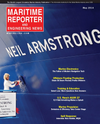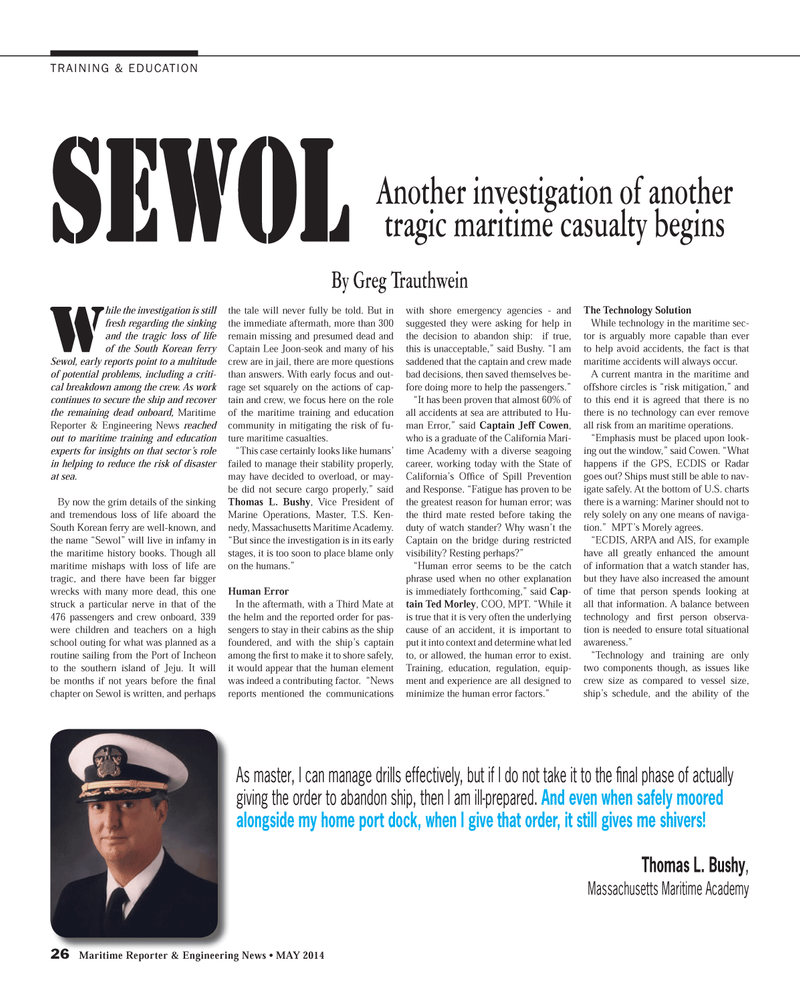
Page 26: of Maritime Reporter Magazine (May 2014)
Marine Electronics Edition
Read this page in Pdf, Flash or Html5 edition of May 2014 Maritime Reporter Magazine
26 Maritime Reporter & Engineering News • MAY 2014 w hile the investigation is still fresh regarding the sinking and the tragic loss of life of the South Korean ferry
Sewol, early reports point to a multitude of potential problems, including a criti- cal breakdown among the crew. As work continues to secure the ship and recover the remaining dead onboard, Maritime
Reporter & Engineering News reached out to maritime training and education experts for insights on that sector’s role in helping to reduce the risk of disaster at sea.
By now the grim details of the sinking and tremendous loss of life aboard the
South Korean ferry are well-known, and the name “Sewol” will live in infamy in the maritime history books. Though all maritime mishaps with loss of life are tragic, and there have been far bigger wrecks with many more dead, this one struck a particular nerve in that of the 476 passengers and crew onboard, 339 were children and teachers on a high school outing for what was planned as a routine sailing from the Port of Incheon to the southern island of Jeju. It will be months if not years before the fi nal chapter on Sewol is written, and perhaps the tale will never fully be told. But in the immediate aftermath, more than 300 remain missing and presumed dead and
Captain Lee Joon-seok and many of his crew are in jail, there are more questions than answers. With early focus and out- rage set squarely on the actions of cap- tain and crew, we focus here on the role of the maritime training and education community in mitigating the risk of fu- ture maritime casualties. “This case certainly looks like humans’ failed to manage their stability properly, may have decided to overload, or may- be did not secure cargo properly,” said
Thomas L. Bushy, Vice President of
Marine Operations, Master, T.S. Ken- nedy, Massachusetts Maritime Academy. “But since the investigation is in its early stages, it is too soon to place blame only on the humans.”
Human Error
In the aftermath, with a Third Mate at the helm and the reported order for pas- sengers to stay in their cabins as the ship foundered, and with the ship’s captain among the fi rst to make it to shore safely, it would appear that the human element was indeed a contributing factor. “News reports mentioned the communications with shore emergency agencies - and suggested they were asking for help in the decision to abandon ship: if true, this is unacceptable,” said Bushy. “I am saddened that the captain and crew made bad decisions, then saved themselves be- fore doing more to help the passengers.” “It has been proven that almost 60% of all accidents at sea are attributed to Hu- man Error,” said Captain Jeff Cowen, who is a graduate of the California Mari- time Academy with a diverse seagoing career, working today with the State of
California’s Offi ce of Spill Prevention and Response. “Fatigue has proven to be the greatest reason for human error; was the third mate rested before taking the duty of watch stander? Why wasn’t the
Captain on the bridge during restricted visibility? Resting perhaps?” “Human error seems to be the catch phrase used when no other explanation is immediately forthcoming,” said Cap- tain Ted Morley, COO, MPT. “While it is true that it is very often the underlying cause of an accident, it is important to put it into context and determine what led to, or allowed, the human error to exist.
Training, education, regulation, equip- ment and experience are all designed to minimize the human error factors.”
The Technology Solution
While technology in the maritime sec- tor is arguably more capable than ever to help avoid accidents, the fact is that maritime accidents will always occur.
A current mantra in the maritime and offshore circles is “risk mitigation,” and to this end it is agreed that there is no there is no technology can ever remove all risk from an maritime operations. “Emphasis must be placed upon look- ing out the window,” said Cowen. “What happens if the GPS, ECDIS or Radar goes out? Ships must still be able to nav- igate safely. At the bottom of U.S. charts there is a warning: Mariner should not to rely solely on any one means of naviga- tion.” MPT’s Morely agrees. “ECDIS, ARPA and AIS, for example have all greatly enhanced the amount of information that a watch stander has, but they have also increased the amount of time that person spends looking at all that information. A balance between technology and fi rst person observa- tion is needed to ensure total situational awareness.” “Technology and training are only two components though, as issues like crew size as compared to vessel size, ship’s schedule, and the ability of the
TRAINING & EDUCATION sewol
Another investigation of another tragic maritime casualty begins
By Greg Trauthwein 26
As master, I can manage drills effectively, but if I do not take it to the fi nal phase of actually giving the order to abandon ship, then I am ill-prepared. And even when safely moored alongside my home port dock, when I give that order, it still gives me shivers!
Thomas L. Bushy,
Massachusetts Maritime Academy
MR #5 (26-31).indd 26 5/2/2014 9:05:11 AM

 25
25

 27
27
